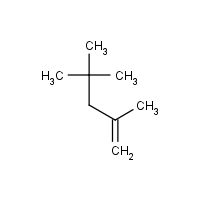Diisobutylene
Agent Name
Diisobutylene
Alternative Name
2,4,4-Trimethyl-1-pentene
CAS Number
107-39-1; 25167-70-8
Formula
C8-H16
Major Category
Other Classes

Synonyms
1-Methyl-1-neopentylethylene; 1-Pentene, 2,4,4-trimethyl-; 2,2,4-Trimethyl-4-pentene; 2,4,4-Trimethyl-1-pentene; [ChemIDplus] UN2050
Category
Aliphatics, Unsaturated
Description
Colorless liquid with an odor of gasoline; [HSDB]
Sources/Uses
Used in organic synthesis and in antioxidants, surfactants, lube additives, plasticizers, and rubber chemicals; Also used as a dispersant (co-monomer with maleic anhydride); [HSDB] Used in organic synthesis and to improve paper coatability; [AIHA]
Comments
A skin, eye, and respiratory tract irritant; [ICSC] Inhalation of high concentrations can cause CNS depression; May act as a simple asphyxiant at high vapor concentrations; [HSDB] An irritant; [MSDSonline] A CNS depressant; [AIHA]
Biomedical References
Exposure Assessment
Vapor Pressure
44.7 mm Hg
Lethal Concentration
LC50 (rat) = 6,875 ppm/4h
Explanatory Notes
Flash point = -5 deg C; [ICSC] The Guide in the Emergency Response Guidebook is for "Diisobutylene, isomeric compounds." VP from ChemIDplus;
NFPA
may ignite at ambient temp
WEEL
75 ppm
Adverse Effects
Neurotoxin
Acute solvent syndrome
Diseases, Processes, and Activities Linked to This Agent
Diseases
Occupational diseases associated with exposure to this agent:
Processes
Industrial Processes with risk of exposure: